Acanthoscelides atrocephalus (Pic, 1938) and Its Potential for Biological Control of Two Weed Species
Abstract
1. Introduction
2. Materials and Methods
2.1. Study Characterization
2.2. Taxonomic Analysis
2.3. Quantification of Seed Damage Caused by A. atrocephalus
3. Results
3.1. Taxonomy
3.2. Material Examined
3.3. Diagnosis
3.4. Description
3.5. Distribution
3.6. Biological Notes
3.7. Natural Occurrence of Angiquinho Seed-Beetle Acanthoscelides atrocephalus
3.8. Damage to Aeschynomene Seeds Caused by A. atrocephalus
4. Discussion
5. Conclusions
Author Contributions
Funding
Data Availability Statement
Acknowledgments
Conflicts of Interest
References
- Johnson, C.D. Seed beetles host specifity and the systematics of the Leguminosae. In Advances in Leguminosae Systematics; Polhill, R.M., Raven, P.H., Eds.; Royal Botanic Gardens, Kew: London, UK, 1981; Volume 2, pp. 995–1027. [Google Scholar]
- Ribeiro-Costa, C.S.; Almeida, L.M. Seed-Chewing Beetles (Coleoptera: Chrysomelidae, Bruchinae). In Insect Bioecology and Nutrition for Integrated Pest Management; Panizzi, A.R., Parra, J.R.P., Eds.; CRC Press, Taylor and Francis Group: Boca Raton, FL, USA; EUA: Brussels, Belgium, 2012; pp. 325–352. [Google Scholar]
- Janzen, D.H. Seed predation by animals. Annu. Rev. Ecol. Evol. Syst. 1971, 2, 465–492. [Google Scholar] [CrossRef]
- Morse, G.E. Bruchinae Latreille, 1802. In Morphology and Systematics: Phytophaga; Leschen, R.A.B., Beutel, R.G., Eds.; Arthropoda: Insecta: Coleoptera; De Gruyter: Berlin, Germany; Boston, MA, USA, 2014; Volume 3, pp. 189–198. [Google Scholar]
- Anton, K.W. New nomenclatural and taxonomic acts. Chrysomelidae: Bruchinae. In Chrysomeloidea II (Orsodacnidae, Megalopodidae, Chrysomelidae); Updated and Revised Second Edition; Catalogue of Palaearctic Coleoptera, Volume 6/2/1; Bezděk, J., Sekerka, L., Eds.; Koninklijke Brill: Leiden, The Netherlands, 2024; pp. 3–24. [Google Scholar]
- Borowiec, L. The genera of seed-beetles (Coleoptera: Bruchidae). Pol. J. Entomol. 1987, 57, 3–207. [Google Scholar]
- Kergoat, G.J.; Alvarez, N.; Hossaert-McKey, M.; Faure, N.; Silvain, J.-F. Parallels in the evolution of the two largest New and Old World seed-beetle genera (Coleoptera, Bruchidae). Mol. Ecol. 2005, 14, 4003–4021. [Google Scholar] [CrossRef] [PubMed]
- Kljajic, P.; Andric, G.; Golic, M.; Jovicic, I. Bean weevil Acanthoscelides obtectus (Say) survival and progeny production affected by residual insecticide deposits, and related damage of two types of bean. J. Stored Prod. Res. 2022, 98, 102004. [Google Scholar] [CrossRef]
- Redmon, S.G.; Forrest, T.G.; Markin, G.P. Biology of Bruchidius villosus (Coleoptera: Bruchidae) on Scotch broom in North Carolina. Fla. Entomol. 2000, 83, 242–253. [Google Scholar] [CrossRef]
- Radford, I.J.; Nicholas, M.; Brown, J.R. Assessment of the biological control impact of seed predators on the invasive shrub Acacia nilotica (prickly acacia) in Australia. Biol. Control 2001, 20, 261–268. [Google Scholar] [CrossRef]
- Agostinetto, D.; Ulguim, A.D.R.; Vargas, L. Controle de plantas daninhas: Manejo de plantas daninhas em sistema plantio direto. In Capítulo 04 em Sistema de Plantio Direto no Brasil, 1st ed.; Aldeia Norte Editora: Passo Fundo, Brazil, 2022; pp. 106–118. [Google Scholar]
- Nunes, F.S.; Schaedler, C.E.; Chiapinotto, D.M. Levantamento Fitossociológico de Plantas Daninhas na Cultura do Arroz Irrigado. Planta Daninha 2018, 36. [Google Scholar] [CrossRef]
- Constantin, J. Métodos de Manejo. In Biologia e Manejo de Plantas Daninhas; Ominipax: Curitiba, Brazil, 2011; pp. 67–78. [Google Scholar]
- Adegas, F.S.; Silva, A.F.; Concenço, G. Controle biológico de plantas daninhas. In Bioinsumos na Cultura da Soja; Meyer, M.C., Bueno, A.F., Mazaro, S.M., Silva, J.C.d., Eds.; Embrapa: Brasília, Brazil, 2022; Chapter 16; pp. 285–295, 550. [Google Scholar]
- Takanose, Y.; Ishida, S.; Kudo, N.; Kamitani, T. Effects of tillage and irrigation on the occurrence and establishment of native wetland plant species in fallow paddy fields. Paddy Water Environ. 2013, 11, 45–58. [Google Scholar] [CrossRef]
- Pei, Q.; Yuanlain, C.; Huanhão, H.; Bo, L. Efeito da irrigação por inundação e padrões de irrigação intermitente na diversidade da comunidade de ervas daninhas em campos de arroz tardios. Trans. Queixo. Soc. Eng. Agríc. 2015, 31, 115–121. [Google Scholar]
- Fruet, B.L.; Merotto, A., Jr.; Ulguim, A.R. Levantamento sobre manejo de plantas daninhas de arroz e características de consultores públicos e privados no sul do Brasil. Weed Technol. J. 2019, 1, 1–22. [Google Scholar]
- Andres, A.; Theisen, G. Épocas de Controle de Angiquinho e Prejuízos em Arroz Irrigado cv. BRS Querência; Boletim de Pesquisa e Desenvolvimento 93; Embrapa Clima Temperado: Pelotas, Brazil, 2009. [Google Scholar]
- Martins, M.B.; Agostinetto, D.; Fogliatto, S.; Vidotto, F.; Andrés, A. Aeschynomene spp. Identification and Weed Management in Rice Fields in Southern Brazil. Agronomy 2021, 11, 453. [Google Scholar] [CrossRef]
- Montagner, C.C.; Vidal, C.; Acayaba, R.D. Contaminantes emergentes em matrizes aquáticas do Brasil: Cenário atual e aspectos analíticos, ecotoxicológicos e regulatórios. Quim. Nova 2017, 40, 1094–1110. [Google Scholar] [CrossRef]
- Ngwu, C.M.; Odoemelam, S.A.; Nnaji, J.C. A Review on the Synthesis and Application of Nanomaterials for the Removal of Emerging Contaminants from Industrial Wastewater. Comms. Phys. Sci. 2020, 5, 343–357. [Google Scholar]
- Correia, N.M. Comportamento dos Herbicidas no Ambiente; Embrapa Hortaliças: Brasília, Brazil, 2018; 30p. [Google Scholar]
- Vitorino, M.D.; Pedrosa, M.J.H. Controle biológico—Uma alternativa para o controle de invasões biológicas. In O Araçazeiro: Ecologia e Controle Biológico; Pedrosa, M.J.H., Dalmolin, A., Smith, C.W., Eds.; FUPEF: Curitiba, Brazil, 2007; pp. 55–69. [Google Scholar]
- Bhaliya, C.M.; Shekhada, H.A. Role of biological control in plant management. Plant 2023, 7, 1328–1340. [Google Scholar]
- Johnson, C.D. Adaptive radiation of Acanthoscelides in seeds: Examples of legume-bruchid interactions. In Stirton C H, Zarucchi J L (eds) Advances in legume biology. Monogr. Syst. Bot. 1989, 29, 747–779. [Google Scholar]
- Johnson, C.D. Systematics of the seed beetle genus Acanthoscelides (Bruchidae) of Northern South America. Trans. Am. Entomol. Soc. 1990, 116, 297–618. [Google Scholar]
- Kingsolver, J.M. Eighteen new species of Bruchidae, principally from Costa Rica, with host records and distributional notes (Insecta:Coleoptera). In Proceedings of the Biological Society of Washington; Biological Society of Washington: Washington, DC, USA, 1980; Volume 93, pp. 229–283. [Google Scholar]
- Kingsolver, J.M. Handbook of the Bruchidae of the United States and Canada (Insecta, Coleoptera); U.S.D.A. Technical Bulletin Number 1912; United States Department of Agriculture: Washington, DC, USA, 2004; pp. 1–324.
- Manfio, D.; Ribeiro-Costa, C.S.; Caron, E. Phylogeny and revision of the new world seed-feeding bruchine genus Gibbobruchus Pic (Coleoptera: Chrysomelidae). Invertebr. Syst. 2013, 27, 1–37. [Google Scholar] [CrossRef]
- Rodrigues, L.M.d.S. Insetos predadores de sementes e suas relações com a qualidade e a morfologia de frutos e sementes. Ph.D. Thesis, Universidade Estadual Paulista, Instituto de Biociências de Botucatu, Botucatu, Brazil, 2013; 117p. [Google Scholar]
- Brasil Ministério da Agricultura, Pecuária e Abastecimento; Secretaria de Defesa Agropecuária. Regras para Análise de Sementes; MAPA/ACS: Brasília, Brazil, 2009; 399p. [Google Scholar]
- Cabrera, L.; Fernández, L.A. Los ejemplares tipo de Bruchidae (Insecta, Coleoptera) depositados en la coleccion del Museo de La Plata. Rev. Mus. Plata 1998, 30, 1–5. [Google Scholar]
- Blackwelder, R.E. Checklist of the coleopterous insects of Mexico, Central America, the West Indies, and South America. Bull. U. S. Natl. Mus. 1946, 185, 551–763. [Google Scholar] [CrossRef]
- Udayagiri, S.; Wadhi, S.R. Catalog of Bruchidae. Mem. Amer. Ent. Inst. 1989, 45, 1–300. [Google Scholar]
- Johnson, C.D. Ecosystematics of Acanthoscelides (Coleoptera: Bruchidae) of Southern Mexico and Central America. Misc. Publ. Entomol. Soc. Am. 1983, 56, 1–370. [Google Scholar]
- Pereira, A.I.d.A.; Cantuário, F.S.; De Sousa, P.V.; Tavares, W.S.; De Medeiros, M.G.H.; De Melo, W.F. Especificidade de Disonycha (Chrysomelidade) em plantas de caruru e genótipos de batata-doce. In Congresso Brasileiro de Olericultura—Anais; ABH (Associação Brasileira de Horticultura): Minas Gerais, Brazil, 2011; Volume 51, pp. 1100–1107. [Google Scholar]
- Pereira, P.R.V.S.; Salvadori, J.R. Identificação dos principais Coleoptera (Insecta) associados a produtos armazenados. Embrapa Trigo 2006, 75, 33. [Google Scholar]
- Orozco-Almanza, M.S.; León-Gárcia, L.P.; Grether, R.; Gácia-Moya, E. Germination of four species of the genus Mimosa (Leguminosae) in a semi-arid zone of Central Mexico. J. Arid Environ. 2003, 55, 75–92. [Google Scholar] [CrossRef]
- Schelin, M.; Tigabu, M.; Eriksson, I.; Sawadogo, L.; Óden, P.C. Predispersal seed predation in Acacia macrostachya, its impact on seed viability, and germination responses to scarification and dry heat treatments. New For. 2004, 27, 251–267. [Google Scholar] [CrossRef]
- Szentesi, A. Pre-dispersal seed predation by Bruchidius villosus (Coleoptera: Bruchidae) in Laburnum anagyroides (Fabaceae: Genisteae). Community Ecol. 2006, 7, 13–22. [Google Scholar] [CrossRef]
- Kolb, A.; Ehrlén, J.; Eriksson, O. Ecological and evolutionary consequences of spatial and temporal variation in pre-dispersal seed predation. Perspect. Plant Ecol. Evol. Syst. 2007, 9, 79–100. [Google Scholar] [CrossRef]
- Acosta, L.; Agüero, R. El banco de propágulos de malezas en el agroecosistema: Conocimiento actual y propuesta metodológica para su estudio. Agron. Mesoam. 2001, 12, 141–151. [Google Scholar] [CrossRef]
- Nisensohn, L.; Faccini, D.; Montero, G.; Lietti, M. Predación de semillas de Amaranthus quitensis H.B.K. en un cultivo de soja: Influencia del sistema de siembra. Pesq. Agropec. Bras. 1999, 34, 377–384. [Google Scholar] [CrossRef]
- Puricelli, E.J.M.; Faccini, D.; Orioli, G.; Sabbatini, M.R. Seed survival and predation of Anoda cristata in soybean crops. Weed Res. 2005, 45, 477–482. [Google Scholar] [CrossRef]
- Southgate, B.J. Biology of the Bruchidae. Annu. Rev. Entomol. 1979, 24, 449–473. [Google Scholar] [CrossRef]
- Rogers, C.E.; Garrison, J. Seed destruction in indigobush Amorpha by a seed beetle. J. Range Manag. 1975, 28, 241–242. [Google Scholar] [CrossRef]
- Kingsolver, J.M.; Whitehead, D.R. The North and Central American species of Meibomeus (Coleoptera: Bruchidae: Bruchinae); Technical Bulletin 1523; Agricultural Reserach Service, United States Department of Agriculture: Washington, DC, USA, 1976; pp. 1–60.
- Di Iorio, O.R. A new previously predicted larval host for the Asian seed beetle Megabruchidius tonkineus (Pic, 1904), and the incorporation of M. dorsalis (Fahraeus, 1839) to the Argentinian fauna of Bruchinae (Coleoptera: Chrysomelidae). Bol. SEA 2015, 56, 327–334. [Google Scholar]
- Salgado, S.E.; Martin, G.D. Distribution and impact of the Asian seed beetle, Megabruchidius tonkineus (Pic, 1904) (Coleoptera: Chrysomelidae: Bruchinae) on Gleditsia triacanthos L. seeds in South Africa. Afr. Entomol 2023, 31, e13386. [Google Scholar] [CrossRef]
- Szentesi, A. Legume (Fabaceae) and seed beetle (Coleoptera, Chrysomelidae, Bruchinae) species of Europe: Distribution and host specialization. Arthropod-Plant Interact. 2024, 18, 579–598. [Google Scholar] [CrossRef]
- Nápoles, J.R.; Kingsolver, J.M. A New Species of Acanthoscelides Schilsky (Coleoptera: Bruchidae) from México with Some Biological Notes. Neotrop. Entomol. 2009, 38, 497–500. [Google Scholar] [CrossRef]
- Kleinjan, C.A.; Hoffmann, J.H.; Heystek, F.; Ivey, P.; Kistensamy, Y. Developments and prospects for biological control of Prosopis (Leguminosae) in South Africa. Afr. Entomol. 2021, 29, 859–874. [Google Scholar] [CrossRef]
- Zachariades, C. A catalogue of natural enemies of invasive alien plants in South Africa: Classical biological control agents considered, released and established, exotic natural enemies present in the field, and bioherbicides. Afr. Entomol. 2021, 29, 1077–1142. [Google Scholar] [CrossRef]
- Cardina, J.; Norquay, H.M.; Stinner, B.R.; McCartney, D.A. Postdispersal predation of velvetleaf (Abutilon theophrasti) seed. Weed Sci. 1996, 44, 534–539. [Google Scholar] [CrossRef]
- Sharratt, M.E.J.; Olckers, T. The Biological Control Agent Acanthoscelides macrophthalmus (Chrysomelidae: Bruchinae) Inflicts Moderate Levels of Seed Damage on Its Target, the Invasive Tree Leucaena leucocephala (Fabaceae), in the KwaZulu-Natal Coastal Region of South Africa. Afr. Entomol. 2012, 20, 44–51. [Google Scholar] [CrossRef]
- Helman, S.; Sobrero, M.T.; Raña, E. Bruchine-predated seeds of Ipomoea nil (L.) Roth., a cotton crop weed in Santiago del Estero, Argentina. Planta Daninha 2020, 38, e020194688. [Google Scholar] [CrossRef]
- Raghu, S.; Wiltshire, C.; Dhileepan, K. Intensity of pre-dispersal seed predation in the invasive legume Leucaena leucocephala is limited by the duration of pod retention. Austral Ecol. 2005, 30, 310. [Google Scholar] [CrossRef]
- Hoffmann, J.H.; Moran, V.C. The population dynamics of an introduced tree, Sesbania punicea, in South Africa, in response to long-term damage caused by different combinations of three species of biological control agents. Oecologia 1998, 114, 343–348. [Google Scholar] [CrossRef]

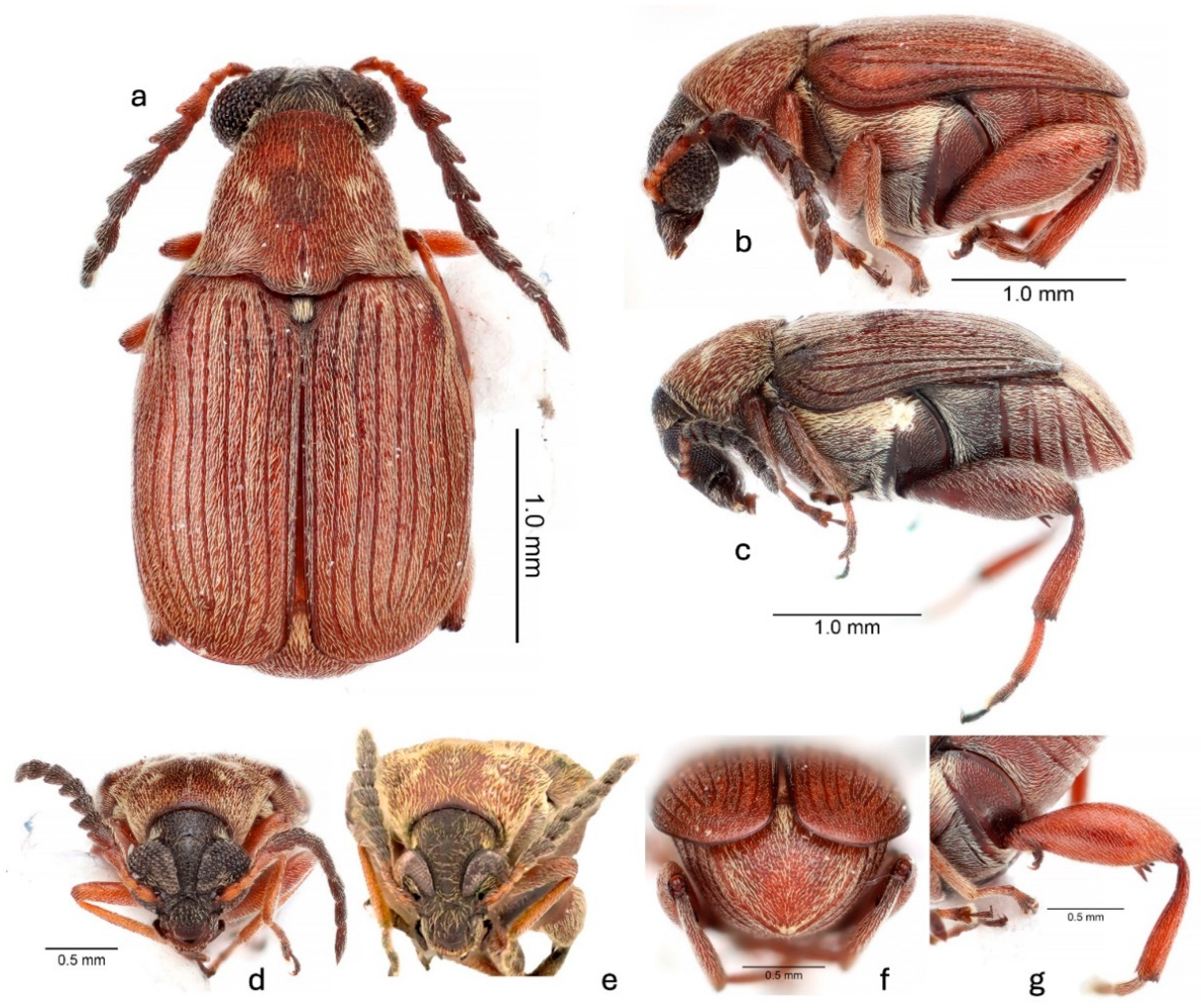
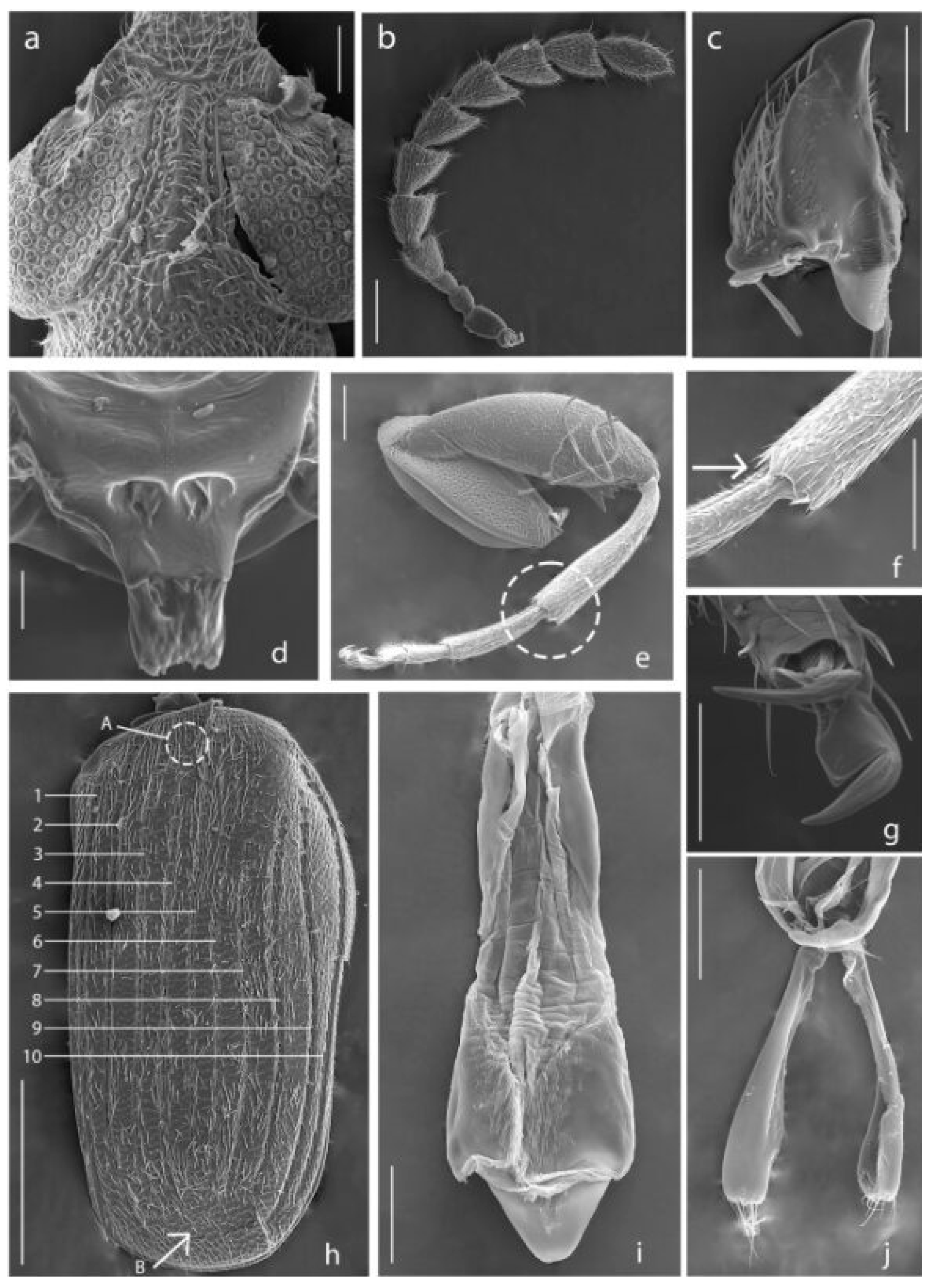
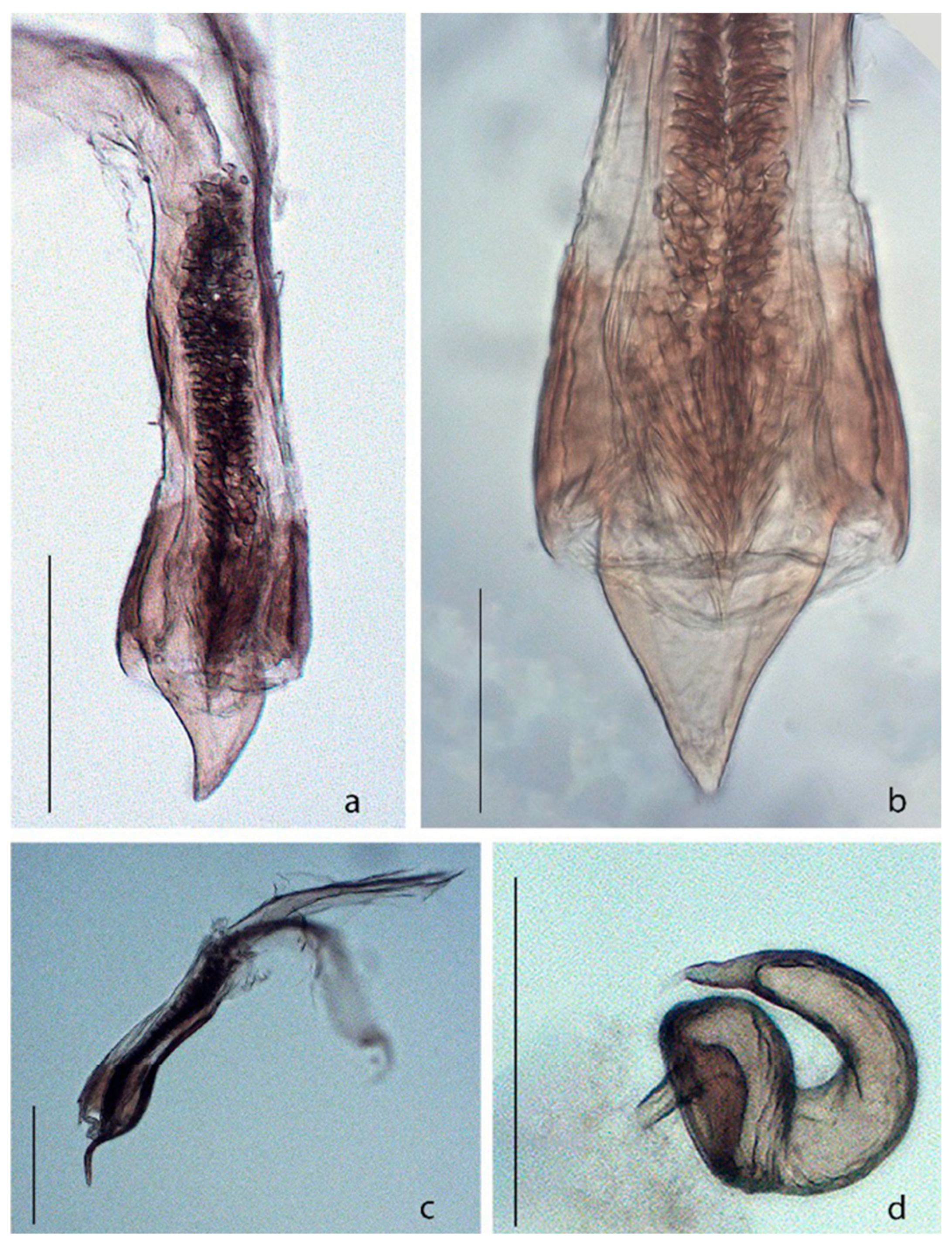
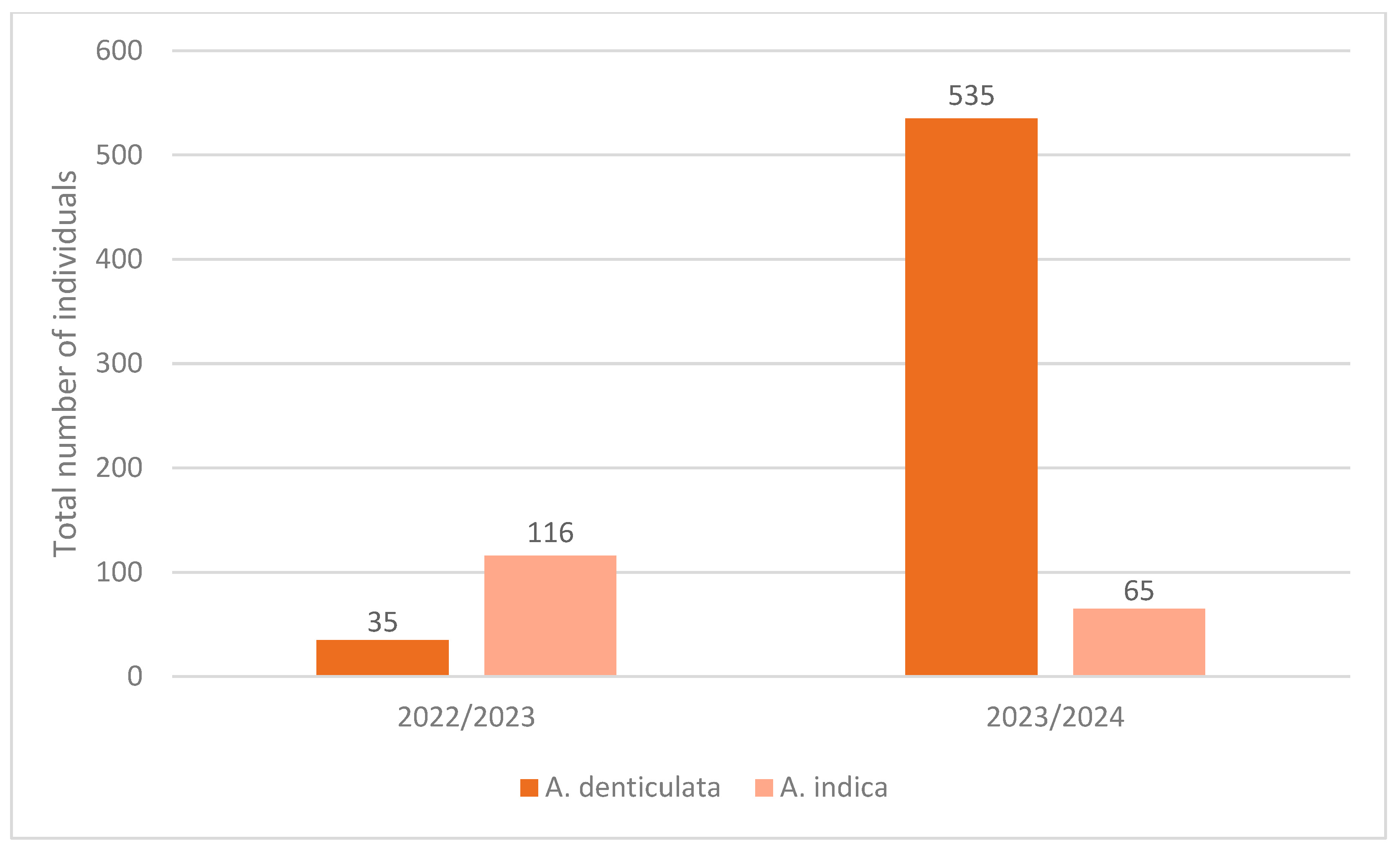


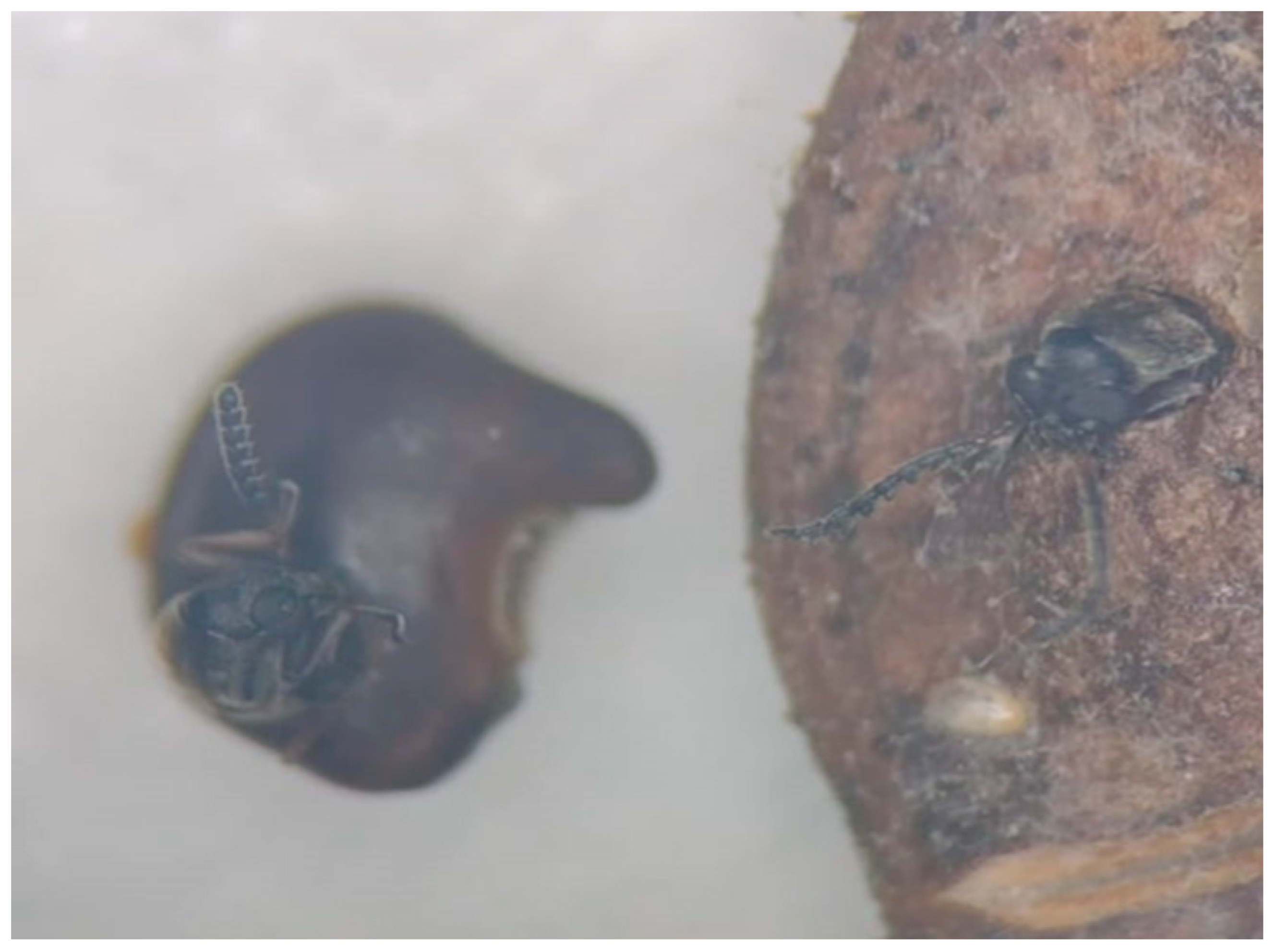
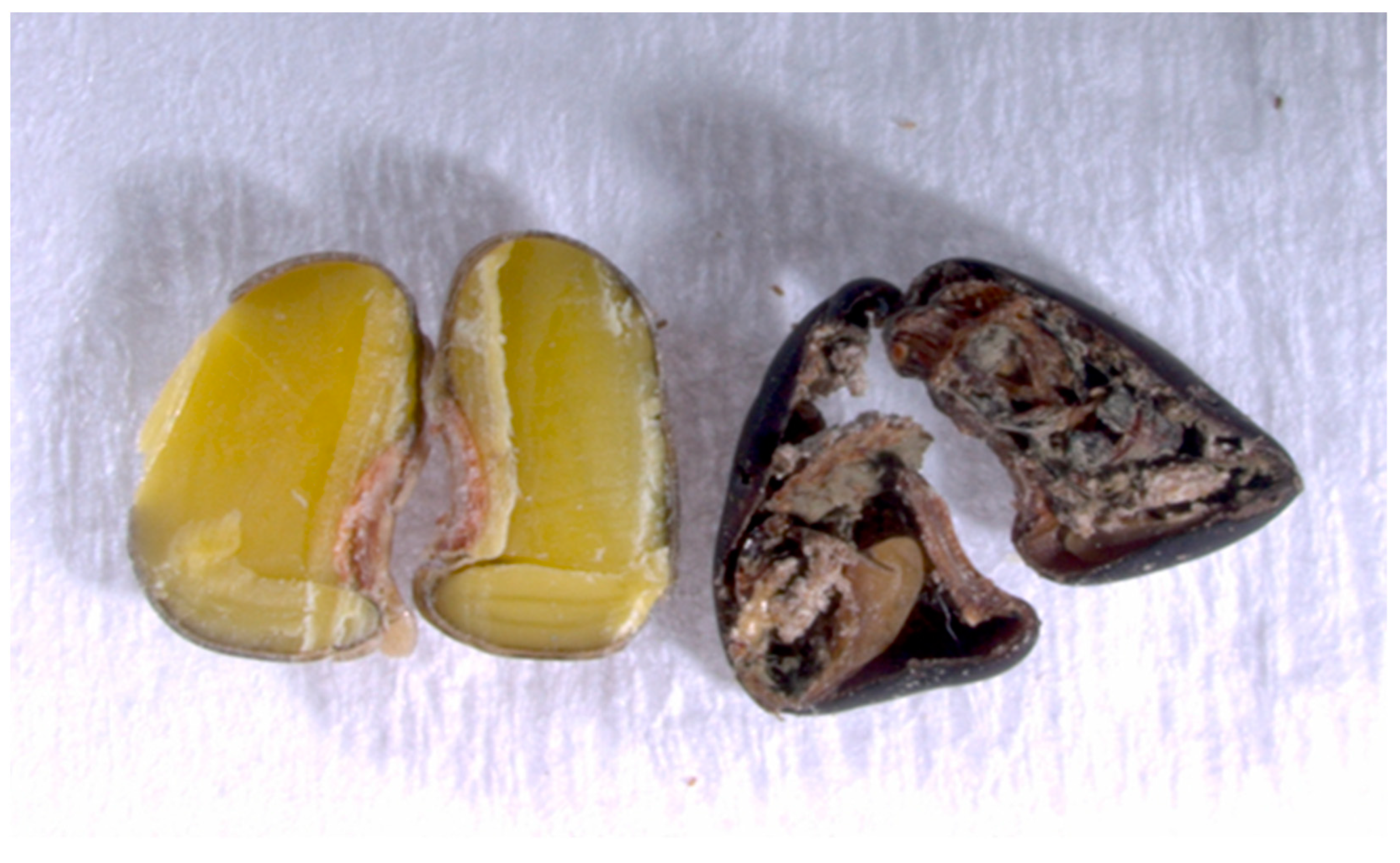
| Period/Weed | A. denticulata | A. indica |
|---|---|---|
| 2022–2023 | 0.55% | 1.34% |
| 2023–2024 | 6.28% | 2.28% |
| Weed/Treatment | Whole Seeds | Drilled Seeds |
|---|---|---|
| A. denticulata | 40% | 0% |
| A. indica | 52% | 0% |
Disclaimer/Publisher’s Note: The statements, opinions and data contained in all publications are solely those of the individual author(s) and contributor(s) and not of MDPI and/or the editor(s). MDPI and/or the editor(s) disclaim responsibility for any injury to people or property resulting from any ideas, methods, instructions or products referred to in the content. |
© 2025 by the authors. Licensee MDPI, Basel, Switzerland. This article is an open access article distributed under the terms and conditions of the Creative Commons Attribution (CC BY) license (https://creativecommons.org/licenses/by/4.0/).
Share and Cite
Greco, M.G.d.C.E.; Correia, E.S.; Morse, G.; Caron, E.; Agostinetto, D.; Garcia, F.R.M. Acanthoscelides atrocephalus (Pic, 1938) and Its Potential for Biological Control of Two Weed Species. Agronomy 2025, 15, 315. https://doi.org/10.3390/agronomy15020315
Greco MGdCE, Correia ES, Morse G, Caron E, Agostinetto D, Garcia FRM. Acanthoscelides atrocephalus (Pic, 1938) and Its Potential for Biological Control of Two Weed Species. Agronomy. 2025; 15(2):315. https://doi.org/10.3390/agronomy15020315
Chicago/Turabian StyleGreco, Mayara Guelamann da Cunha Espinelli, Enrique Soratto Correia, Geoffrey Morse, Edilson Caron, Dirceu Agostinetto, and Flávio Roberto Mello Garcia. 2025. "Acanthoscelides atrocephalus (Pic, 1938) and Its Potential for Biological Control of Two Weed Species" Agronomy 15, no. 2: 315. https://doi.org/10.3390/agronomy15020315
APA StyleGreco, M. G. d. C. E., Correia, E. S., Morse, G., Caron, E., Agostinetto, D., & Garcia, F. R. M. (2025). Acanthoscelides atrocephalus (Pic, 1938) and Its Potential for Biological Control of Two Weed Species. Agronomy, 15(2), 315. https://doi.org/10.3390/agronomy15020315







